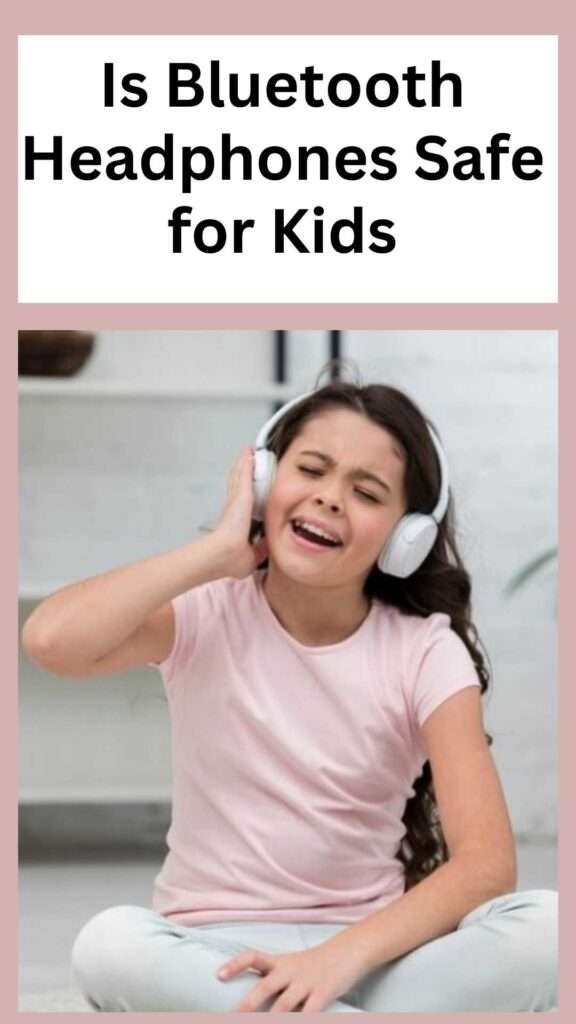Bluetooth headphones have become an essential part of our daily lives, providing ease and flexibility when listening to music, watching films, and engaging in other forms of audio entertainment. As technology improves, wireless devices have made their way into the ears of users of all ages, including youngsters.
However, as parents and caregivers, we are increasingly concerned about the safety of Bluetooth headphones for children.
In this article, we will explore the world of Bluetooth technology, including its functionality and the reasons behind its growing popularity among children. As we progress through this conversation, we’ll tackle the critical question: “is Bluetooth headphones safe for kids?”.
To address this, we will look at potential health hazards linked with Bluetooth use, present safety tips for parents, investigate product features meant for children, and seek advice from pediatric health specialists.
While Bluetooth headphones have unquestionable benefits, we must critically evaluate their impact on our children’s well-being.
Protecting Young Ears: Safety of Bluetooth Headphones for Kids
In this Topic We will cover:-
- Comprehending Bluetooth Technology
- Possible Dangers to Health
- Safety Advice for Children
- Regulations and Product Features
- Other Options for Kids’ Bluetooth Headphones
1. Comprehending Bluetooth Technology

The way we communicate and share information wirelessly has been completely transformed by Bluetooth technology. Understanding Bluetooth’s basic functions is crucial to appreciating how it affects our daily life.
A. Describe the Operation of Bluetooth Technology
- An overview of wireless communication Bluetooth is a protocol for short-range communication.
- fundamental ideas behind radio frequency communication between gadgets.
- The process of pairing involves connecting devices with Bluetooth capabilities.
B. Bluetooth Device Types and Applications
- a wide variety of Bluetooth-capable gadgets, such as speakers, headphones, and smartphones.
- particular uses for Bluetooth technology across a range of gadgets.
- Bluetooth version evolution: from traditional Bluetooth to Low Energy (BLE).
C. How Wired and Wireless Headphones Differ
- The benefits and drawbacks of using wired headphones.
- Among the advantages of wireless Bluetooth headphones is mobility.
- A comparison of wireless and wired choices’ convenience and sound quality.
2. Possible Dangers to Health

Given their popularity and ease of use, Bluetooth headphones have sparked concerns about possible health effects on its users, especially young ones. Even while Bluetooth technology has been shown to be generally safe, it’s important to consider any possible health hazards before using it.
A. Overview of Potential Health Concerns Related to Bluetooth Technology
Electromagnetic Radiation: The explanation for Bluetooth devices’ radiofrequency radiation emissions.
Effects of Heating: Resolving issues with tissues getting heated when they are near Bluetooth gadgets.
Blue Light Exposure: A discussion of the possible effects of blue light emissions from Bluetooth-enabled gadgets.
B. Particular Dangers of Extended Headphone Use
Hearing Loss: Examination of the risk of hearing impairment owing to extended exposure to loud noises.
Ear Infections: A link has been shown between prolonged headphones use and an elevated risk of ear infections.
Effect on Concentration: Talking about how children’s focus and attention span may be impacted by continuous use.
C. Current Research and Studies on Bluetooth Radiation’s Effects
a summary of research results examining Bluetooth radiation’s impact on health.
identifying areas that need more research and gaps in the current body of knowledge.
recognizing the necessity for continued research and the differences in viewpoints among scientists.
3. Safety Advice for Children

In order to guarantee children use Bluetooth headphones safely, it is necessary to monitor usage, establish age-appropriate guidelines, and be aware of any potential health hazards. Parents should take into consideration these crucial safety guidelines:
A. Age-Related Usage Suggestions
Introduction Age: Depending on the child’s maturity level, determine when it is appropriate to introduce them to Bluetooth headphones.
Limited Screen Time: To encourage a healthy digital lifestyle, link the usage of headphones with the amount of time children should spend on screens.
Teaching Volume Levels: To avoid damaging children’s hearing, teach them about appropriate noise levels and suggest using headphones that have built-in volume controls.
B. Guidelines for Duration and Volume Control
Set Usage restrictions: To avoid overexposure, set sensible daily or weekly restrictions on the usage of headphones.
Employ the Volume Limiting Features: Choose kid-friendly headphones with integrated volume controls to adjust the loudness of the sound.
Promote Breaks: Stress the value of taking pauses to give ears a rest and lower the chance of developing hearing problems.
C. Parental Involvement and Supervision Is Crucial
Parental Controls: To regulate and keep an eye on material and usage, make use of parental controls unique to each device and app.
Encourage youngsters to have open discussions about safe headphones use, associated risks, and the value of self-control.
Model Healthy Behavior: Set a good example for others by using technology sensibly, especially when it comes to using headphones.
4. Regulations and Product Features

Manufacturers are reacting to the growing demand for children’s Bluetooth headphones by releasing products that solve safety issues. Making educated decisions for their children requires parents to be aware of industry laws and features that support the welfare of younger users.
A Review of Kid-Friendly Bluetooth Headphones
Volume Limiting Controls: Stressing the need of using headphones that have built-in volume limits in order to safeguard kids’ hearing.
Size and Durability: Examining headphones made of kid-friendly materials to guarantee size and comfort.
Simple Controls: Children may simply adjust playback and volume with these intuitive controls.
B. Safety Standards and Regulations in the Headphone Sector
Age-Appropriate Compliance: Analyzing industry norms for features and designs that are appropriate for a certain age.
Respect for Volume criteria: Making sure headphones follow established criteria and norms for volume.
Material Safety: Evaluating the safety of headphones’ materials and their adherence to applicable laws.
C. How to Select Bluetooth Headphones While Considering Safety
Research companies: Parents are urged to do their homework and select reliable companies that are recognized for making secure and kid-friendly headphones.
Examine Reviews: using customer reviews to learn about other parents’ actual experiences with comparable products.
Verify Safety Certifications: confirming that headphones are in compliance with industry standards by looking up the necessary safety certifications.
5. Other Options for Kids’ Bluetooth Headphones

Although Bluetooth headphones are multifunctional and convenient, some parents might choose safer options that also address potential health risks. These are some substitutes for Bluetooth-enabled kids’ audio experiences that are nonetheless entertaining.
A. Corded Earbuds
Conventional Wired Options: Investigate wired headphones that offer a straight connection to devices using a normal 3.5mm audio port to eliminate exposure to wireless signals.
Limiting Volume Wired Headphones: Select headphones made especially for kids, with integrated volume control to safeguard their hearing.
Comfort and Sturdiness: Take into account corded headphones with kid-friendly styles that guarantee comfort during prolonged usage and sturdy materials for active lives.
B. Children’s Speakers:
Bluetooth-Free Audio Sharing: Choose family-friendly speakers that allow you to share audio without using separate headphones.
Discover educational speakers that encourage children’s aural development by providing them with interactive learning opportunities.
Parental Control functions: To keep an eye on and manage audio material, look for speakers that have these functions.
C. Earmuffs with over-ear hearing protection:
Dual-Purpose Hearing Protection: Invest in earmuffs that can be used as headphones for audio entertainment and as hearing protection in noisy areas.
Options for Noise-Canceling: Take into consideration earmuffs that can block out background noise and create a safe listening environment without getting in the way of your ears.
Comfortable and Adjustable: Make sure the earmuffs are comfortable enough for prolonged use and can be adjusted to fit a variety of head sizes.
D. Audio Devices Without a Screen:
Investigate gadgets that are devoted to audio storytelling in order to foster creativity and screen-free leisure.
Podcast Players for Kids: Introduce kids to these kid-friendly podcast players that offer instructive and enjoyable content.
Music Players with Parental Controls: To regulate content accessibility, use stand-alone music players with parental control options.
Conclusion
In conclusion, the safety of Bluetooth headphones for children is contingent upon a mix of responsible usage, educated decision-making, and the evaluation of other options.
In this day and age, parents have the ability to offer their children with a pleasant and secure audio experience by remaining informed, enforcing safety rules, and investigating alternatives that are suitable.
Maintaining a proactive and attentive approach ensures that children may enjoy the benefits of modern electronics while protecting their well-being. This is especially important as technology continues to advance.
Frequently Asked Questions
- Are Bluetooth headphones safe for children?
- While Bluetooth headphones are generally considered safe, there are concerns about potential health risks associated with prolonged use, especially among children. It’s important to follow safety guidelines and consider alternatives if necessary.
- What are the potential health risks of Bluetooth headphones?
- Potential health risks include exposure to electromagnetic radiation, heating effects from prolonged use, and the risk of hearing damage due to high volume levels.
- How can I ensure my child’s safety while using Bluetooth headphones?
- Parents can ensure their child’s safety by implementing age-appropriate usage recommendations, controlling volume levels, monitoring duration of use, and choosing headphones with safety features such as volume limiting.

